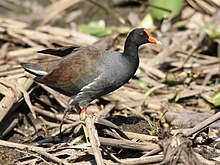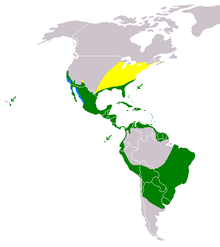Gallinula galeata
| Common gallinule | |
|---|---|
 |
|
| Common gallinule | |
| Scientific classification | |
| Kingdom: | Animalia |
| Phylum: | Chordata |
| Class: | Aves |
| Order: | Gruiformes |
| Family: | Rallidae |
| Genus: | Gallinula |
| Species: | G. galeata |
| Binomial name | |
|
Gallinula galeata (Lichtenstein, 1818) |
|
| Subspecies | |
|
About 7; see text |
|
 |
|
| Range of G. galeata Breeding range Year-round range Wintering range | |
| Synonyms | |
|
Gallinula brodkorbi McCoy, 1963 |
|
About 7; see text
Gallinula brodkorbi McCoy, 1963
The common gallinule (Gallinula galeata) is a bird in the family Rallidae. It was split from the common moorhen by the American Ornithologists' Union in July 2011. It lives around well-vegetated marshes, ponds, canals, and other wetlands in the Americas. The species is not found in the polar regions or many tropical rainforests. Elsewhere, the common gallinule is likely the most commonly seen rail species in much of North America, excepting the American coot in some regions.
The gallinule has dark plumage apart from the white undertail, yellow legs and a red frontal shield. The young are browner and lack the red shield. It has a wide range of gargling calls and will emit loud hisses when threatened.
This is a common breeding bird in marsh environments and well-vegetated lakes. Populations in areas where the waters freeze, such as southern Canada and the northern USA, will migrate to more temperate climes. This species will consume a wide variety of vegetable material and small aquatic creatures. It forages beside or in the water, sometimes upending in the water to feed. Its wide feet allow it to hop about on lily pads. It is often secretive, but can become tame in some areas. Despite loss of habitat in parts of its range, the common gallinule remains plentiful and widespread.
The common gallinule will fight to defend its territory. The nest is a basket built on the ground in dense vegetation. Laying starts in spring, between mid-March and mid-May in northern hemisphere temperate regions. About 8 eggs are usually laid per female early in the season; a brood later in the year usually has only 5–8 or even fewer eggs. Nests may be re-used by different females. Incubation lasts about three weeks. Both parents incubate and feed the young. These fledge after 40–50 days, become independent usually a few weeks thereafter, and may raise their first brood the next spring. When threatened, the young may cling to a parent's body, after which the adult birds fly away to safety, carrying their offspring with them.
...
Wikipedia

